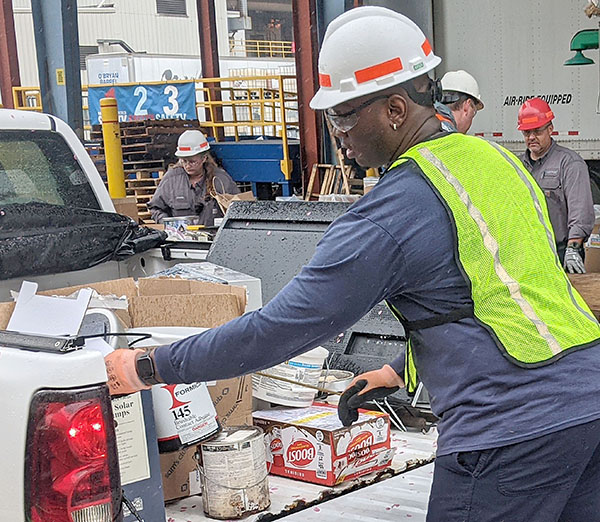As we said in Tuesday’s post on the Rebuttable Presumption, the current used oil management standards can get confusing when it comes to mixing used oil with other things. We will be breaking used oil mixtures into four categories; used oil mixed with hazardous waste, used oil mixed with solid waste, used oil mixed with products, and other mixtures.
How do you manage used oil mixed with hazardous waste?
As with most any other type of waste, a used oil combined with a listed hazardous waste must be managed as a hazardous waste. If, however, a used oil is mixed with a characteristic hazardous waste, the rules are not quite as simple. The EPA cites two separate scenarios to help generators determine if a mixture must be handled as hazardous waste or if it can be handled as a used oil.
“The first scenario involves used oil that is mixed with a waste that is hazardous solely because it exhibits the characteristic of ignitability. If the resultant mixture is no longer ignitable, then the mixture can be managed as used oil, despite the inherent characteristics that the used oil may bring to the mixture… The second scenario involves used oil mixed with a waste that is hazardous because it exhibits one or more characteristic of hazardous waste (other than just ignitability). The resultant mixture must no longer exhibit any characteristics if it is going to be managed as used oil.”
The difference between the two scenarios is so important because used oil often displays a characteristic of hazardous waste from its normal use. The EPA provides the following example, “used oil that displays the toxicity characteristic for lead (D008) is mixed with an ignitable hazardous waste (D001). Section 279.10(b)(2)(iii) allows this mixture to remain under the umbrella of used oil regulation even if it fails the Toxicity Characteristic Leaching Procedure (TCLP) for lead (D008), as long as the mixture is no longer ignitable. On the other hand, if the D008 used oil had been mixed with a reactive waste (D003), then the resultant mixture would need to be void of both characteristics in order to be managed as used oil. Otherwise, the mixture would need to be managed as hazardous waste.”
How is used oil mixed with solid waste managed?
The regulations for used oil mixed with solid waste aren’t nearly as stringent. According to the EPA, any material that is contaminated with a used oil or that is contaminating a used oil is regulated as a used oil. After the contaminating oil has been appropriately removed/drained from the mixture to the best extent possible (no visible signs of free-flowing oil) remaining wastes can be classified as solid waste. Any oil separated from the solid waste must be disposed of as such. “The exception to this is that a solid waste from which free-flowing used oil has been removed is still subject to regulation as used oil if it is burned for energy recovery.”
How do you manage used oil mixed with products?
According to the EPA, “the blending of used oil generated in diesel-powered vehicles with diesel fuel is excluded from the processing and re-refining standards when the mixture is used in the generator’s own vehicles as a fuel. The mixture itself is also specifically excluded when used in this manner.”
What do you do with other mixtures?
The EPA states that “used oil that is considered to be a hazardous waste solely because it exhibits one or more characteristic of hazardous waste, because it has been mixed with hazardous waste subject to the special provisions of §261.5 for conditionally exempt small quantity generators (CESQGs), or because it has been mixed with household hazardous waste is subject to regulation as a used oil, not as a hazardous waste.”
Quoted and EPA cited information (unless otherwise noted) for this blog post was gathered from the EPA document, “RCRA, Superfund & EPCRA Call Center Training Module: Used Oil” As always, this blog post is not intended to be comprehensive and it is always best to check with the EPA and local government for full, up-to-date, rules and regulations.
More News From Heritage
-
6/27/24
Heritage Environmental Services to Acquire EBV from General Dynamics
Heritage Environmental Servicess, an EQT Infrastructure portfolio company, will acquire EBV from General Dynamics
-
6/13/24
Meet The Facilities – East Liverpool
An inside look at our incineration facility located in East Liverpool, OH
-
5/24/24
Habitat for Humanity 2024
Heritage hosted our 14th annual Habitat for Humanity build this month, partnering with over 50 employees from various THG companies.
-
5/6/24
Date set for the household hazardous waste collection in East Liverpool, Ohio
-
3/12/24
Equal Pay Day – Spotlighting Our Female Drivers
-
3/8/24
International Women’s Week Spotlight – Shannon Dippel
For International Women's Week, we're spotlighting some of the incredible women in the Heritage family. Our final spotlight is Shannon Dippel.
-
3/8/24
International Women’s Week Spotlight – Susan Adams
For International Women's Week, we're spotlighting some of the incredible women in the Heritage family. Our sixth spotlight is Susan Adams.
-
3/7/24
International Women’s Week Spotlight – Lea Wilson
For International Women's Week, we're spotlighting some of the incredible women in the Heritage family. Our fifth spotlight is Lea Wilson








